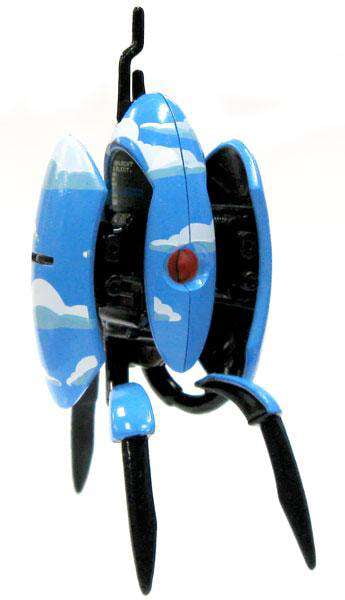

The design of channels and protrusions were done with 45 degree chamfers, so "hanging in space" elements will be minimal. Any larger and openings started appearing in the body near the infill strip. I found that 0.2mm worked well in the slicer and produced a decent result. The bump on the front and rear can be virtually eliminated with good filament and some good print settings. There is the large gap in the sides that has to be bridged, but I really had no big issues with pretty standard settings, other than the bump.

The body was printed in the vertical position, with no supports. The print orientation should be pretty evident. These were printed on a Prusa Mk2, using PLA for all parts. Not true to original, but it's at the back, and allows one to use a straight mini-USB connector straight up. Portal turret v4.zip is updated and should contain all printed parts needed to build the latest turret. This made manipulating and keeping sub-assemblies linked for quick access. I learned quite a bit on this project, such as using embedded components within other components. This was pretty taxing, as there really aren't many boxy shapes in this thing, and it closes up pretty tightly, with no real access for tweaking once put together. This model is what came of those changes. Once that worked out, I went back to the model and made some tweaks to improve appearance and assemblability (is that a word?). Once the entire model was built and I was confident that it would work, and could be built (printed) and assembled, I went ahead and printed out the parts and built a prototype. Why? Because I wanted to use a crank mechanism, that's why! This added some complications, but it also had a benefit once the geometry was determined, operational repeatability would be ensured and the min and max limits were pretty much guaranteed. The wing opening mechanism was a crank and slide mechanism. Printed parts to be as large as possible (not a lot of little pieces)Īfter components (Nano, other chips, servos) were added to the basic shape, they were moved around and positioned as required, and the supporting structures were built to support them inside the shell.A 2.1mm electrical connector for power at the back.Time-of-flight sensor should be invisible as well.MicroSD card had to be accessible in the same manner, and ideally invisible once installed.Arduino Nano had to have connector accessible for updating once fully assembled.All electronics were built in Fusion as components that were inserted and placed where I thought it would make sense. Then it was a matter of extruding them into 3D, then shelling the general shape and making cuts. Using these images as canvases, I started sketching the outlines of the 3 views. The design started from sketches found online. This sensor is nearly invisible from the front once assembled. The lidar sensor (time-of-flight) is on a chip with a rectangular profile. 18 individual expressions and sounds used in this go-round. It is inline with the black infill strip, making it essentially invisible once installed. The sounds are stored on a microSD card, which is accessible from the back side so that sounds may be updated or changed later. With some basic sketches found online, I started modelling and planning. I took some liberties in the design, trying to make it appreciably the same as the one seen in the game, but functional and printable. Use Portal turret sounds and voices from the game.Close up and go to sleep until someone else comes along.If the person is no longer there, run a little scanning search routine.If the person is still there after opening, fire until they drop.Use a crank mechanism with sliders, just because. Open the "wings" if it senses someone in front.The goal here was to make it move in 3 "axes", with spoken sound from the game and LED's to simulate firing. This design uses an Arduino Nano, an MP3 player chip, distance sensor, servos, LEDs and 3D printed parts. For me, this was an exercise of properly modelling the entire assembly in Fusion 360 first, before building anything. This Christmas, I decided to design and build a working Portal turret gun from the game Portal 2. You can also view a database of all of the turrets at. Here is a list of every single item from all 4 series's of NECA's Portal Turret Blind Boxes


 0 kommentar(er)
0 kommentar(er)
